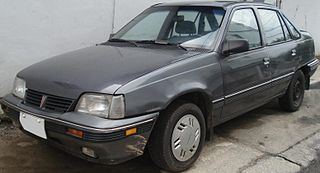 W
WThe Daewoo LeMans is a compact car, first manufactured by Daewoo in South Korea between 1986 and 1994, and between 1994 and 1997 as Daewoo Cielo — a car mechanically identical to the LeMans, differentiated only by its modified styling cues. Like all Daewoos preceding it, the LeMans took its underpinnings from a European Opel design. In the case of the LeMans, the GM T platform-based Opel Kadett E was the donor vehicle, essentially just badge engineered into the form of the LeMans, and later as the Cielo after a second more thorough facelift.
 W
WThe Buick LaCrosse is a mid-size sedan manufactured and marketed by Buick since 2004. The LaCrosse is now in its third generation, slotted above the Buick Regal as the brand's flagship vehicle.
 W
WThe Honda Legend is a V6-engined executive car produced by Honda since 1985 which currently serves as its flagship vehicle. It is larger than the Honda Accord. It also provided the basis for the Acura Legend, RL and RLX — the successive flagship vehicles of Honda's luxury Acura division in North America from 1986 until 2020.
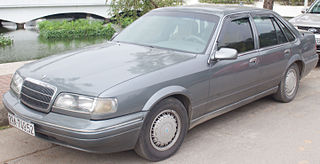 W
WThe Daewoo Prince is a mid-size luxury car that was produced by Daewoo in South Korea between 1991 and 1997. The car was based on the rear-wheel drive Opel Rekord E, although the body was of Daewoo design, as opposed to the Opel-designed, Holden-manufactured body of the Prince's Royale predecessor. The Prince was powered by 1.8- and 2.0-litre Opel Family II four-cylinder engines. The Prince spawned two additional variants, the Daewoo Brougham and the Daewoo Super Salon, all three replaced by the Daewoo Chairman in 1997.
 W
WThe SsangYong Chairman is a full-size luxury car that was manufactured by South Korean automaker SsangYong from 1997 to 2017. The original model was renamed to Chairman H in 2008, with a new model introduced in the same year and designated Chairman W.
 W
WThe Suzuki Carry is a kei truck produced by the Japanese automaker Suzuki. The microvan version was originally called the Carry van until 1982 when the passenger van versions were renamed as the Suzuki Every . In Japan, the Carry and Every are kei cars but the Suzuki Every Plus, the bigger version of Every, had a longer bonnet for safety purposes and a larger 1.3-liter 86-hp (63 kW) four-cylinder engine. They have been sold under myriad different names in several countries, and is the only car to have been offered with Chevrolet as well as Ford badges.
 W
WThe Suzuki Carry is a kei truck produced by the Japanese automaker Suzuki. The microvan version was originally called the Carry van until 1982 when the passenger van versions were renamed as the Suzuki Every . In Japan, the Carry and Every are kei cars but the Suzuki Every Plus, the bigger version of Every, had a longer bonnet for safety purposes and a larger 1.3-liter 86-hp (63 kW) four-cylinder engine. They have been sold under myriad different names in several countries, and is the only car to have been offered with Chevrolet as well as Ford badges.
 W
WThe Daewoo Espero is a four-door, five-seater mid-sized notchback saloon produced by the South Korean company Daewoo Motors from September 1990 to 1997. It was technically based on the GM J platform. The body was designed by Bertone. Daewoo also said that the Espero's design was their own work. It was done in a consultation with Italian design master Bertone. The car was equipped with a Holden-built GM Family 1 1.5 L 90 hp engine, or the 1.8 95 hp or 2.0 L 108.5 hp Family II engine. The Espero was replaced by the Daewoo Leganza in 1997.
 W
WThe Daewoo LeMans is a compact car, first manufactured by Daewoo in South Korea between 1986 and 1994, and between 1994 and 1997 as Daewoo Cielo — a car mechanically identical to the LeMans, differentiated only by its modified styling cues. Like all Daewoos preceding it, the LeMans took its underpinnings from a European Opel design. In the case of the LeMans, the GM T platform-based Opel Kadett E was the donor vehicle, essentially just badge engineered into the form of the LeMans, and later as the Cielo after a second more thorough facelift.
 W
WThe Daewoo FX212 Super Cruiser is a heavy-duty luxury coach manufactured by the South Korean bus producer Daewoo. It was introduced in 2007, part of the FX series of current coaches that started with the FX115 and FX116 Cruising Arrow, and the FX120 Cruising Star. It is primarily available as luxury hi-decker tourist buses. It is assembled in Ulsan, South Korea. It is distinguishable by an 'FX212 Super Cruiser' or 'FX212 Super Star' badge, but the common Daewoo badge is usually on the rear. Principal competitors has been both the Hyundai Universe and Kia Granbird.
 W
WThe Saturn Sky is a roadster that was produced by Saturn, and was initially released in the first quarter of 2006 as a 2007 model. It uses the Kappa automobile platform shared with the Pontiac Solstice. The Sky concept was shown at the 2005 North American International Auto Show, with the production version following at the 2006 show. It was built at GM's Wilmington Assembly plant in Wilmington, Delaware, alongside the Solstice. The Sky featured 18-inch (457 mm) wheels and a 2.4 L Ecotec LE5 I4 engine that produced 177 hp (132 kW), a new straight-4 2.0 L turbocharged direct injected engine that made 260 hp (194 kW) as well as an optional dealer-installed turbo upgrade kit that made 290 hp (216 kW). Both five-speed manual and automatic transmissions were available.
 W
WThe Daewoo LeMans is a compact car, first manufactured by Daewoo in South Korea between 1986 and 1994, and between 1994 and 1997 as Daewoo Cielo — a car mechanically identical to the LeMans, differentiated only by its modified styling cues. Like all Daewoos preceding it, the LeMans took its underpinnings from a European Opel design. In the case of the LeMans, the GM T platform-based Opel Kadett E was the donor vehicle, essentially just badge engineered into the form of the LeMans, and later as the Cielo after a second more thorough facelift.
 W
WThe Chevrolet Aveo (T200) is the first generation of the Chevrolet Aveo, a subcompact automobile from the Chevrolet division of the American manufacturer General Motors, launched in 2002, developed by the initially independent South Korean manufacturer Daewoo, later GM Korea. It was originally marketed as the Daewoo Kalos and prominently marketed as the Aveo. The model received the T200 internal codes during the car's development. The T250 code was designated for the model's facelift.
 W
WThe SsangYong Korando is a mini SUV or compact crossover SUV built by the South Korean automobile manufacturer SsangYong from 1983 to 2006 and from 2010 onwards. The name Korando is a contraction of "Korea Can Do". The Korando brand is listed in the Guinness Book of Records as Korea’s longest surviving name plate.
 W
WThe Suzuki Carry is a kei truck produced by the Japanese automaker Suzuki. The microvan version was originally called the Carry van until 1982 when the passenger van versions were renamed as the Suzuki Every . In Japan, the Carry and Every are kei cars but the Suzuki Every Plus, the bigger version of Every, had a longer bonnet for safety purposes and a larger 1.3-liter 86-hp (63 kW) four-cylinder engine. They have been sold under myriad different names in several countries, and is the only car to have been offered with Chevrolet as well as Ford badges.
 W
WThe Daewoo Lacetti is a compact car manufactured and marketed globally by GM Korea since 2002.
 W
WThe Chevrolet Cruze is a compact car that has been made by the Chevrolet division of General Motors since 2008. The nameplate has been used previously in Japan, for a version of a subcompact hatchback car produced under a joint venture with Suzuki from 2001 to 2007, and was based on the Suzuki Ignis.
 W
WThe Daewoo Lanos is a subcompact car produced by the South Korean manufacturer Daewoo from 1997 to 2002, and thereafter produced under license agreements in various countries worldwide. It has also been marketed as the Daewoo Sens, ZAZ Sens and ZAZ Lanos in Ukraine, Doninvest Assol and ZAZ Chance in Russia, FSO Lanos in Poland, or Chevrolet Lanos in Ukraine, Russia, and Egypt.
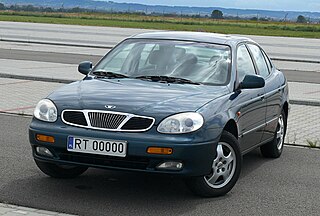 W
WThe Daewoo Leganza is a mid-size sedan produced by Daewoo in South Korea between 1997 and 2002. Its internal development name was V100, under which it and its platform are also known. Daewoo explained that the name Leganza originated from the combination of two Italian words – elegante (elegant) and forza (power).
 W
WThe Daewoo LeMans is a compact car, first manufactured by Daewoo in South Korea between 1986 and 1994, and between 1994 and 1997 as Daewoo Cielo — a car mechanically identical to the LeMans, differentiated only by its modified styling cues. Like all Daewoos preceding it, the LeMans took its underpinnings from a European Opel design. In the case of the LeMans, the GM T platform-based Opel Kadett E was the donor vehicle, essentially just badge engineered into the form of the LeMans, and later as the Cielo after a second more thorough facelift.
 W
WThe Daewoo Maepsy is a compact car manufactured by Daewoo in South Korea from December 1977 to 1989. The Maepsy was a badge engineered version of the Opel Kadett C, or to be more precise, of the PF50 Isuzu Gemini. Originally the car was sold as the Saehan Gemini, but in February 1982 the car evolved to become the Saehan Maepsy. By 1983 it was called the Daewoo Maepsy after Saehan Motor was bought out by the Daewoo Group, and finally the Daewoo Maepsy-Na. The word "maepsy" means "beautiful" in Korean.
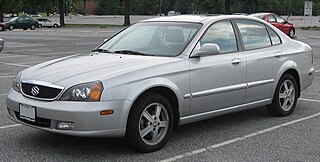 W
WThe Daewoo Magnus is a mid-sized sedan developed and manufactured by Daewoo from 2000 to 2006. GM Daewoo and other General Motors divisions, as well as GMDAT stake holder Suzuki, have marketed this car under different badges in various countries. The car is also known under its internal Daewoo designation of V200. The Project Manager was Dr. W.J Lee.
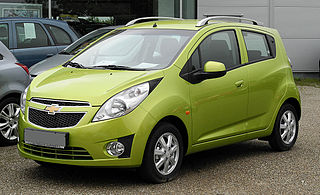 W
WThe Chevrolet Spark is a city car manufactured by General Motors's subsidiary GM Korea, currently in its fourth generation. The vehicle initially introduced in 1998 as the Daewoo Matiz.
 W
WThe Chevrolet Spark is a city car manufactured by General Motors's subsidiary GM Korea, currently in its fourth generation. The vehicle initially introduced in 1998 as the Daewoo Matiz.
 W
WThe Daewoo Musiro was the penultimate concept vehicle to emerge from Daewoo's UK Worthing Technical Centre product development facility. Launched at the 2000 British Motor Show British International Motor Show the Musiro built on Daewoo's emerging 'Designed Around You' product mantra and was a distillation of the earlier and more advanced 1999 Mirae show car's Versatile Sports Car (VSC) concept.
 W
WThe SsangYong Musso is a mid-sized SUV or pickup truck manufactured by the South Korean automaker SsangYong from 1993.
 W
WThe Daewoo LeMans is a compact car, first manufactured by Daewoo in South Korea between 1986 and 1994, and between 1994 and 1997 as Daewoo Cielo — a car mechanically identical to the LeMans, differentiated only by its modified styling cues. Like all Daewoos preceding it, the LeMans took its underpinnings from a European Opel design. In the case of the LeMans, the GM T platform-based Opel Kadett E was the donor vehicle, essentially just badge engineered into the form of the LeMans, and later as the Cielo after a second more thorough facelift.
 W
WThe Daewoo Nubira is a compact car which was produced by the South Korean automaker Daewoo from 1997 to 2002 as a 4-door sedan, 5-door hatchback and a 5-door station wagon.
 W
WThe Daewoo LeMans is a compact car, first manufactured by Daewoo in South Korea between 1986 and 1994, and between 1994 and 1997 as Daewoo Cielo — a car mechanically identical to the LeMans, differentiated only by its modified styling cues. Like all Daewoos preceding it, the LeMans took its underpinnings from a European Opel design. In the case of the LeMans, the GM T platform-based Opel Kadett E was the donor vehicle, essentially just badge engineered into the form of the LeMans, and later as the Cielo after a second more thorough facelift.
 W
WThe Daewoo Prince is a mid-size luxury car that was produced by Daewoo in South Korea between 1991 and 1997. The car was based on the rear-wheel drive Opel Rekord E, although the body was of Daewoo design, as opposed to the Opel-designed, Holden-manufactured body of the Prince's Royale predecessor. The Prince was powered by 1.8- and 2.0-litre Opel Family II four-cylinder engines. The Prince spawned two additional variants, the Daewoo Brougham and the Daewoo Super Salon, all three replaced by the Daewoo Chairman in 1997.
 W
WThe Daewoo LeMans is a compact car, first manufactured by Daewoo in South Korea between 1986 and 1994, and between 1994 and 1997 as Daewoo Cielo — a car mechanically identical to the LeMans, differentiated only by its modified styling cues. Like all Daewoos preceding it, the LeMans took its underpinnings from a European Opel design. In the case of the LeMans, the GM T platform-based Opel Kadett E was the donor vehicle, essentially just badge engineered into the form of the LeMans, and later as the Cielo after a second more thorough facelift.
 W
WThe Opel Speedster is a mid-engined, targa-topped, two-seat sports car sold by German automaker Opel and introduced in July 2000. It was built in both RHD and LHD versions at the Lotus Cars plant in Hethel, Norfolk, England. It was presented at the Geneva Motor Show in March 1999 and went into full production the following year.
 W
WThe Daewoo Prince is a mid-size luxury car that was produced by Daewoo in South Korea between 1991 and 1997. The car was based on the rear-wheel drive Opel Rekord E, although the body was of Daewoo design, as opposed to the Opel-designed, Holden-manufactured body of the Prince's Royale predecessor. The Prince was powered by 1.8- and 2.0-litre Opel Family II four-cylinder engines. The Prince spawned two additional variants, the Daewoo Brougham and the Daewoo Super Salon, all three replaced by the Daewoo Chairman in 1997.
 W
WThe Daewoo Tacuma is a compact MPV that was produced by South Korean manufacturer Daewoo. Developed under the U100 code name, it was designed by Pininfarina and is based on the original Daewoo Nubira J100, a compact car.
 W
WThe Daewoo Tico is a city car produced by the South Korean automaker Daewoo from 1991 to 2001.
 W
WThe Daewoo Tosca is a mid-size car designed by Daewoo in South Korea and marketed by Chevrolet as the Chevrolet Epica and Chevrolet Tosca, while Holden marketed it as the Holden Epica. Codenamed V250, it replaces the Daewoo Magnus and its derivatives. The Chevrolet Epica was officially launched in Europe at the 2006 Geneva Motor Show. The Tosca is noteworthy in that it is available with transversely-mounted straight-six engines. Contrary to the preceding models, which were styled by Giugiaro, the V250 was designed entirely in-house.
 W
WThe WM and WN series Holden Caprice are a line of full-size/executive cars produced by the Australian manufacturer Holden from September 2006 to October 2017, sold primarily in Australia and New Zealand. They were also exported in various guises to the United States, the Middle East, China and South Korea. The range debuted alongside the smaller VE series Holden Commodore, which the Caprice shares its "Zeta" platform with, on 16 July 2006 at the Melbourne Convention and Exhibition Centre.
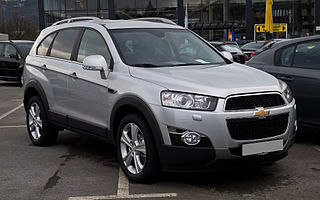 W
WThe Chevrolet Captiva is a compact crossover SUV developed by General Motors. The first generation was developed by GM Korea, based on the GM Theta platform and derived from the S3X concept car revealed in 2004. The crossover straddles the entry-level SUV segments. Released in 2006, it was sold internationally as Chevrolet Captiva, in Australia and New Zealand as Holden Captiva and in South Korea as Daewoo Winstorm until 2011, when the international name was adopted. The Theta platform also underpins the Opel Antara. On 13 September 2018, Chevrolet announced that it is ending production on the first generation Captiva and replacing it worldwide with the Equinox. The second generation Captiva, which is a rebadged Baojun 530, was introduced in Colombia in November 2018 and Thailand in March 2019.
 W
W